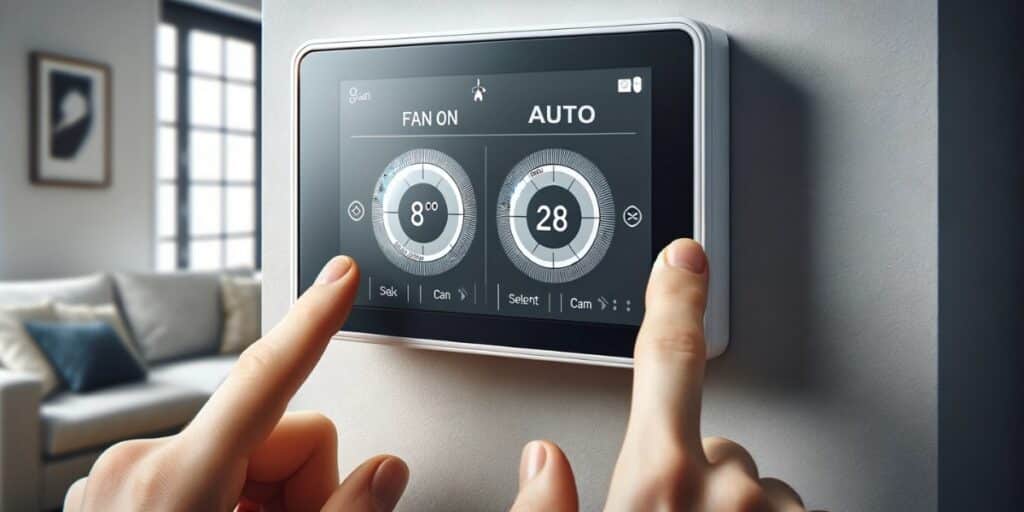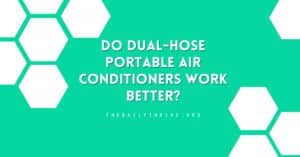When managing the comfort and efficiency of your home’s heating system, a key question often arises: should the fan be on when the heat is on? This decision is more than just a matter of flipping a switch; it involves understanding the dynamics of your HVAC system and balancing various factors such as energy efficiency, air quality, and personal comfort.
HVAC systems, integral to our homes, not only control temperature but also play a crucial role in maintaining indoor air quality and overall comfort. The fan within these systems is pivotal, determining how air circulates when the heating is active. You have the option to set your fan to “on” for continuous operation or “auto,” where it runs only during heating cycles.
The “on” setting ensures even heat distribution and continuous air filtration, which is beneficial for allergy sufferers or when you need consistent temperature throughout your home. However, it also means higher energy usage and more frequent maintenance, like filter changes. The “auto” setting, while more energy-efficient, may result in less consistent air circulation and filtration.
Through this discussion, you’ll gain a deeper understanding of each fan setting and its impact, empowering you to make an informed decision that best suits your home’s needs.
The Role of the Fan in HVAC System
At the core of your home’s heating and cooling system lies a vital component – the fan.

Integral to the airflow process, the fan’s role is twofold: it draws air to be heated or cooled by the system. Then, it propels this conditioned air through vents into your living spaces. The fan is the force behind the comforting breeze from a vent when the system is in operation.
When the heat is on, the fan plays a crucial role in distributing the warm air generated by the unit system. Engaging the fan along with the heating system brings several advantages:
- Even Heat Distribution: The fan aids in avoiding hot and cold spots in your home, promoting a uniformly comfortable temperature.
- Enhanced Air Quality: The continuous movement of air facilitated by the fan contributes to the filtration and purification of indoor air, thereby reducing allergens and pollutants.
Modern HVAC systems are designed with flexibility in mind. Typically, these systems present options for fan operation, such as “on” or “auto,” allowing homeowners to align the fan’s functioning with their individual comfort preferences and energy efficiency objectives. This adaptability positions the fan as a central element in managing your home’s climate.
Understanding Fan Settings in Heating and Cooling Systems
As heating costs continue to rise, homeowners often face the dilemma of choosing between comfort and cost-saving. This is especially true during winter when operating a heating system becomes more complex. A key aspect of this complexity involves the fan settings on your thermostat, specifically whether to set it to “on” or “auto.”
Let’s break down what these settings mean and their implications.
“On” Setting
The “on” setting in an HVAC system is designed to continuously operate the furnace fan. This mode keeps the fan running non-stop, regardless of the active heating cycle. Such continuous operation ensures a consistent air flow from the vents, providing steady air circulation throughout your home.
Pros and Cons of the “On” Setting
| Pros | Cons |
|---|---|
| Even Distribution of Heat Continuous fan operation leads to a more uniform distribution of heat, effectively reducing hot or cold zones in your home. | Increased Energy Costs Continuous operation of the fan increases energy consumption, which can lead to higher utility bills. |
| Enhanced Air Filtration Constant air movement means more air passes through the filter, improving air quality and potentially reducing the spread of airborne illnesses. | Frequent Filter Changes Continuous circulation results in more dust being trapped, necessitating more frequent filter changes. |
| Cooler Feeling in Summer The continuous airflow can create a cooler sensation during warm months, similar to the effect of a ceiling fan. | Potential for Colder Sensation in Winter Continuous air movement can create a wind chill effect, making it feel cooler during colder months. |
| Reduced Wear on Fan Motor Constant operation can mitigate the stress of frequent starts and stops on the motor, potentially extending its lifespan. | Strain on Air Conditioner In summer, continuous operation may draw more warm air into the home, increasing the workload on your air conditioning unit. |
| Aid in Cleaning Running the fan while cleaning can help capture more dust and allergens, improving indoor air quality. |
“Auto” Setting
An HVAC system’s “auto” setting allows the fan to operate cyclically. In this mode, the fan activates only during the heating or cooling cycles. Consequently, airflow occurs exclusively when the system is heating or cooling, leading to intervals of no air movement when the system is off.
Pros and Cons of the “Auto” Setting
| Pros | Cons |
|---|---|
| Energy Efficiency The fan consumes energy only during active heating or cooling cycles, which contributes to reduced overall energy usage. | Stagnant Air Between Cycles The lack of continuous air movement can make spaces feel stuffy or stagnant. |
| Longer Filter Life Less frequent operation of the fan means air filters don’t clog as quickly, extending their usable life. | Increased Wear on Fan The constant starting and stopping associated with the “auto” setting can cause premature wear and tear on the fan. |
| Efficient Dehumidifying Shutting off the fan between cycles allows for better moisture control, as it aids in the dehumidification process. | Reduced Air Filtration With less air movement, air filtration is less frequent, which can impact the overall air quality in your home. |
Which Thermostat Setting Is Best: On or Auto?
Selecting the ideal fan setting in your HVAC system is not a one-size-fits-all decision. It largely depends on various factors, such as personal comfort, energy efficiency goals, air quality concerns, and the specific characteristics of your home. Understanding when to use the “auto” versus “on” setting can significantly impact your home’s comfort and efficiency.

Here are some situations where switching from “auto” to “on” might be beneficial:
- Allergy Considerations
- If your household includes allergy sufferers, especially during peak allergy seasons like spring, using the “on” setting can be advantageous.
- Continuous air circulation helps the AC filter out allergens like pollen from the air. Ensure your HVAC system has high-quality filters that trap fine pollen and dust particles.
- During Cleaning Activities
- Cleaning activities like vacuuming, sweeping, and dusting tend to make dust and pet dander airborne.
- Keeping the fan in the “on” position during cleaning can assist in capturing these particles, pulling them into the HVAC filters, and improving indoor air quality.
- When Hosting Guests
- Continuous air circulation can prevent your home from feeling stuffy if you’re entertaining many guests.
- This is particularly useful in maintaining a comfortable environment in spaces where people congregate.
- Balancing Temperature in Different Areas
- In homes with areas that are notably warmer or colder than others, continuous fan operation can help equalize temperatures.
- This ensures that all parts of your home are uniformly comfortable.
- During Periods of HVAC Dormancy
- In mild weather conditions, such as late spring or early fall, your HVAC system might remain unused for extended periods, leading to stagnant air.
- Running the fan occasionally and opening windows can facilitate air circulation, keeping your home’s air fresh and preventing stuffiness.
Factors to Consider When Choosing a Fan Setting
The choice between the “on” vs “auto” settings on your HVAC system’s fan should be made after considering the specific needs.
- Energy Efficiency vs. Comfort
Balancing energy costs with comfort is key. While the “on” setting enhances comfort and air quality, it does consume more energy. On the other hand, the “auto” setting is more energy-efficient. Still, it may compromise on continuous air filtration and even temperature distribution. - Maintenance and Longevity of the System
Consider the impact of each setting on the maintenance needs and longevity of your HVAC system. Continuous operation (on) might mean more frequent filter changes and potentially longer fan life, whereas the “auto” setting could lead to less wear but more start-stop cycles. - Specific Home Conditions
Assess the unique aspects of your home, such as size, layout, insulation quality, and the presence of hot or cold spots, when deciding on the fan setting. - Air Quality Needs
If improving indoor air quality is a priority, particularly for allergy sufferers or in high-pollutant areas, the continuous filtration provided by the “on” setting could be more beneficial.
Final Verdict
Should the fan be on when the heat is on? The answer depends largely on your individual needs and preferences. Whether “on” for continuous operation or “auto” for cyclic operation plays a significant role in your home’s comfort, energy efficiency, and air quality. As we’ve explored, each setting has unique advantages and disadvantages, making the decision highly dependent on individual circumstances and preferences.
Ultimately, the key to maximizing comfort and efficiency lies in understanding the dynamics of your home’s heating and cooling needs and making informed choices that align with your lifestyle. By thoughtfully considering the role of your HVAC fan and adjusting its settings to suit different situations, you can ensure a comfortable, healthy, and energy-efficient home environment year-round.






